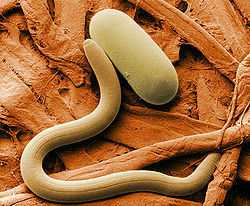- Microfauna
-
Microfauna (Ancient Greek mikros "small" + New Latin fauna "animal") refers to microscopic organisms that exhibit animal-like qualities. Microfauna are represented in the animal kingdom (e.g., nematodes, small arthropods) and the protist kingdom (i.e., protozoans). This is in contrast to microflora.
Contents
Habitat
Microfauna are often associated with other microscopic organisms in a variety of habitats, notably in soil, in water, and in the bodies of larger organisms (including the human body). Some microfauna are sessile, meaning they attach to a substrate their entire lives and never move. Sessile microfauna fertilize their mates by releasing ciliated sperm, while they themselves stay put.
Role
One particular example of the role of microfauna can be seen in soil, where they are important in the cycling of nutrients in ecosystems. Soil microfauna are capable of digesting just about any organic substance, and some inorganic substances (such as TNT and synthetic rubber).
Cryptozoa
The microfauna are the least understood of soil life, due to their small size and great diversity. Many microfauna are members of the so-called cryptozoa, animals that remain undescribed by science. Out of the estimated 10-20 million animal species in the world, only 1.8 million have been given scientific names, and many of the remaining millions are likely microfauna, much of it from the tropics.
See also
External links
The role of soil microfauna in Plant disease suppression. University of California
Categories:- Zoology
- Animal stubs
- Microbiology stubs
Wikimedia Foundation. 2010.

